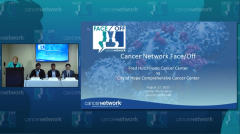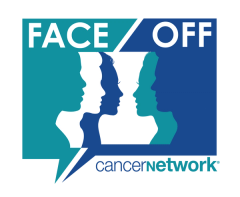
Optimizing Ponatinib in CML: Understanding AOEs in the PACE Trial
A retrospective analysis of arterial occlusive events in the PACE trial, shedding light on risk factors and management strategies for ponatinib treatment in CML patients.
Episodes in this series

Transcript:
Judy Schreiber, PhD, RN: Now we’re going to move on from multiple myeloma to CML [chronic myeloid leukemia]. And our first speaker is going to be Dr Koller. And there [are] 3 abstract papers that he’s putting together.… We’re going to keep going through the talk and do the questions at the end of that, because they’re all related to ponatinib. So, thank you.
Paul B. Koller, MD: Hi. Paul Koller here from City of Hope in the Division of Leukemia. I’m going to talk about CML and optimizing ponatinib. The first article we’re going to talk about was published in the Journal of Hematology & Oncology in 2022. It was a retrospective analysis of arterial occlusive events [AOEs] in the [phase 2] PACE trial [NCT01207440] by an independent adjudication committee. The PACE trial was the trial to get ponatinib approved…for patients with CML. And one of the things that became readily apparent with the PACE trial was that there were significant arterial occlusive events noted. And so, one of the things we have learned in the last 10, 15 years with ponatinib is how to dose it and to reduce the number of these events so the drug can be used more frequently.
So, they took PACE trial data, 449 patients, they reviewed records. They identified events…using terms to identify and verify events. They selected these events and then reviewed and verified the events by an adjudication committee, who, of note, were not hematologists and were cardiologists. So the adjudication process is here. They were 2 cardiologists who looked at events, death, VTE [venous thromboembolism], arterial events, heart failure events, and looked to see if there was an agreement. And then if there wasn’t, they were adjudicated…by an appropriate specialist. So that’s where the data for this comes from.
And so, what they…noticed after having a relevant disease expert look at this was that—and this is something that [we] have talked about in CML, which is risk factor reduction, this vague notion of this risk factor reduction with ponatinib—the more risks you have for arterial events, increases the frequency of arterial events. And…they looked at…time on drug and looked at events over time, and they noted that the events did not increase over time. The gray is nonadjudicated, which is how the study was initially reported. And then the red is adjudicated, just showing the new events.
Unsurprisingly—actually, I guess reassuringly—adjudication attributed less AOEs than the original study reported.… There’s a fairly big discrepancy…between what’s been reported and…what people see in clinical practice with ponatinib. And I think before…some of the more modern data, and I’d love to hear what Dr Oehler thinks of this, I think at academic centers, we were a lot more comfortable with ponatinib and…it was pretty good for business, ponatinib having this black box warning. Because we’d get a lot of referrals for how to put people on ponatinib.
And the risk factors here are listed, which would include age over 65, male, history of ischemic disease, diabetes, history of venous or arterial clots, high blood pressure, high cholesterol, obesity, and nonischemic cardiac disease. And these are just general cardiovascular risk factors that I think anyone with some internal medicine training is aware of. So the key takeaways from this study were that increased risk factors for arterial occlusive events increase the rate of arterial occlusive events. Arterial occlusive rates did not increase over time. Based on this…cardiovascular adjudication process, they were lower, but still quite high. And then the risk factors for AOEs with patients on ponatinib include standard AOE risk factors. So, I’ll repeat those again: age, male sex, history of ischemia, history of blood clots, diabetes, hyperlipidemia, obesity, and nonischemic heart disease.
Transcript is AI-generated and edited for clarity and readability.
Newsletter
Stay up to date on recent advances in the multidisciplinary approach to cancer.
































































































